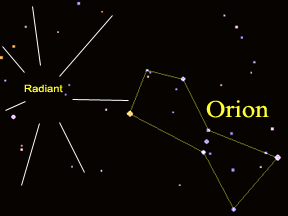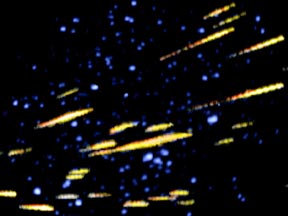Sky Maps
Click on a city below to see a map of the stars for that city. New cities will continue to be added, so don't worry if you do not see one near you. Each city has a map for one day in each of the twelve months. There are two maps for two different times during the given night. So, click on a city to find your path to the stars!
 Constellations
Constellations
 Portraits of stars and their constellations Created by Jim Kaler , Prof. of Astronomy, University of Illiniois.
Portraits of stars and their constellations Created by Jim Kaler , Prof. of Astronomy, University of Illiniois.
 Sky and Telescope - What's Up in the Sky This Week?
Sky and Telescope - What's Up in the Sky This Week?
 Starry Night Software A program for all your sky watching needs...
Starry Night Software A program for all your sky watching needs...
You might also be interested in:

The Orionid meteor shower is one of several major meteor showers that occur on roughly the same date each year. The Orionids typically "peak" (are at their greatest level of activity) around October 21st.
...more
A meteor shower is an astronomical event during which many meteors can be seen in a short period of time. Most meteor showers have a peak activity period that lasts between several hours and a couple of
...more
In the 1960's, the United States launched a series of satellites to look for very high energy photons, called Gamma Rays, that are produced whenever a nuclear bomb explodes. These satellites soon detected
...more
The introduction of telescopes to the study of astronomy opened up the universe, but it took some time for astronomers to realize how vast the universe could be. Telescopes revealed that our night sky
...more
Neutron Stars are the end point of a massive star's life. When a really massive star runs out of nuclear fuel in its core the core begins to collapse under gravity. When the core collapses the entire star
...more
Spiral galaxies may remind you of pinwheels turning slowly as though in some intergalactic breeze. They are rotating disks of gas, dust and stars. Through a telescope or binoculars, the bright nucleus
...more
White Dwarfs are the remnants of stars that were massive enough to stay alive using nuclear fusion in their cores, but not massive enough to blow apart in a Type II supernova. When stars like our own sun
...more
 Portraits of stars and their constellations Created by Jim Kaler , Prof. of Astronomy, University of Illiniois.
Portraits of stars and their constellations Created by Jim Kaler , Prof. of Astronomy, University of Illiniois.
 Sky and Telescope - What's Up in the Sky This Week?
Sky and Telescope - What's Up in the Sky This Week?
 Starry Night Software A program for all your sky watching needs...
Starry Night Software A program for all your sky watching needs...














